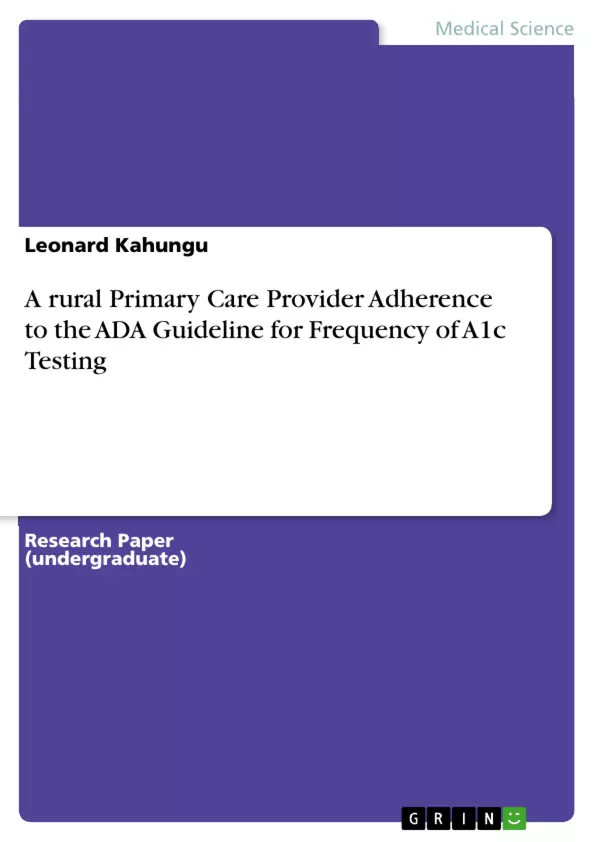The purpose of this scholarly project is to examine the effects of motivational interviewing (MI), on T2DM patient adherence to A1c testing.
The overarching research question for this scholarly project is as follows: In adult patients (18 years and older) with T2DM located in a southern Mississippi outpatient setting, what are the effects (if any) of motivational interviewing on patients’ adherence to recommended A1c testing?
Diabetes mellitus (DM) is worldwide epidemic and is the leading cause of poor health, physical disabilities and premature death. Globally, 422 million people were diagnosed with diabetes in 2014, and over 1.5 million people died from diabetes-related complications (World Health Organization, 2016). In the United States (U.S.), diabetes was the cause of over 74.9 thousand deaths and 1.85 million disability years lived in 2013. The widespread presence rate of type 2 diabetes (T2DM) in the U.S. is estimated to reach 44 million by 2034. Presently, nearly 25.8 million adults and children have diabetes, with T2DM being more prevalent in Latinos, African Americans, Asian Americans, Native Americans, other Pacific Islanders and Native Hawaiians (World Health Organization, 2016).
Inhaltsverzeichnis (Table of Contents)
- A rural Primary Care Provider Adherence to the ADA Guideline for Frequency of Alc Testing
- Purpose
- PICO
- Middle Range Theory and EBP Model
- Theory of Prevention as Intervention and Neuman's Systems Model
- Author
- Purpose
- Relevant Major Assumptions
- Major Concepts
- Rationale for Selecting the Theory of Prevention as Intervention and NSM
- Rationale for Selecting the Adherence-to-Awareness Model
- References
Zielsetzung und Themenschwerpunkte (Objectives and Key Themes)
This scholarly project aims to examine the effects of motivational interviewing (MI) on type 2 diabetes (T2DM) patient adherence to Alc testing. The research question explores the impact of MI on patient adherence to recommended Alc testing in a southern Mississippi outpatient setting.
- Adherence to Alc testing in T2DM patients
- Motivational interviewing as an intervention strategy
- The Neuman's Systems Model (NSM) and the theory of prevention as intervention
- Factors influencing patient adherence to healthcare recommendations
- The role of primary care providers in managing T2DM
Zusammenfassung der Kapitel (Chapter Summaries)
- The first chapter introduces the widespread prevalence of diabetes mellitus (DM) and its associated health complications. It outlines the purpose of the scholarly project, which is to investigate the effects of motivational interviewing on T2DM patient adherence to Alc testing. The research question focuses on adult patients (18 years and older) with T2DM in a southern Mississippi outpatient setting.
- The second chapter delves into the middle-range theory and evidence-based practice (EBP) model, specifically focusing on the Neuman's Systems Model (NSM) and the theory of prevention as intervention. The chapter explains the origins and core principles of the NSM, emphasizing its holistic and system-centered approach to patient care. It highlights the key concepts of prevention as intervention and its role in promoting patient stability and wellness.
- The third chapter provides a comprehensive overview of the Neuman's Systems Model (NSM). It discusses the major assumptions and concepts underpinning the model, including the patient's system, stressors, the normal line of defense, and the flexible line of defense. The chapter outlines the different levels of prevention as intervention: primary, secondary, and tertiary. It also emphasizes the dynamic and continuous energy exchange between the patient and their surroundings.
Schlüsselwörter (Keywords)
The core keywords and focus topics of this scholarly project include: type 2 diabetes, Alc testing, motivational interviewing, patient adherence, healthcare interventions, Neuman's Systems Model, prevention as intervention, and primary care.
- Quote paper
- Leonard Kahungu (Author), 2017, A rural Primary Care Provider Adherence to the ADA Guideline for Frequency of A1c Testing, Munich, GRIN Verlag, https://www.grin.com/document/368352



